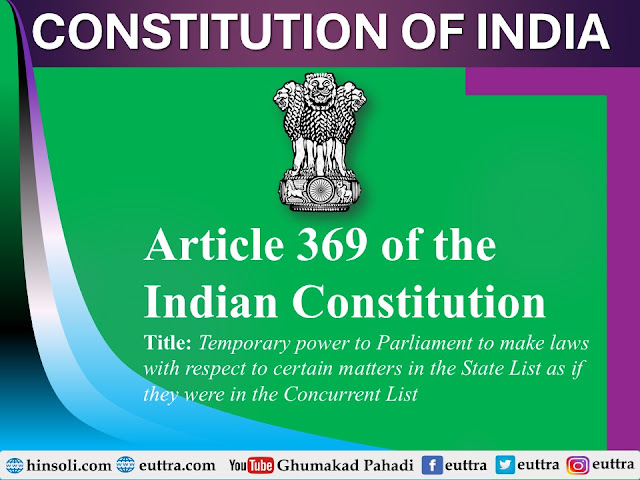 |
| What is Article 369 of Indian constitution |
Article 369 of the Indian Constitution
Title: Temporary power to Parliament to make laws with respect to certain matters in the State List as if they were in the Concurrent List
🔷 Explanation of Article 369:
Article 369 gave the Parliament temporary power to legislate on certain State subjects (normally under State List) for a limited period of 5 years from the commencement of the Constitution (i.e., from 26 January 1950 to 25 January 1955).
🟡 This Article was introduced to help the newly formed Union Parliament handle urgent national issues, even in areas typically reserved for States, during the early years after independence.
✅ Key Provisions of Article 369:
| Clause | Provision |
|---|---|
| (a) | Parliament may make laws on certain matters in the State List, for 5 years from the commencement of the Constitution. |
| (b) | The State List subjects temporarily brought under Parliament's control included: |
| – Trade and commerce in essential supplies | |
| – Production, supply and distribution of foodstuffs, cotton, and wool | |
| – Cattle fodder, raw cotton, and raw jute |
🕰️ Time Limit:
-
The power under Article 369 was valid only till 25 January 1955.
-
After that, Parliament lost this temporary privilege, and those matters reverted to being State subjects.
🎯 Purpose of Article 369:
| Goal | Explanation |
|---|---|
| 🛠️ Transitional Support | Help the Union make laws on key economic issues post-Independence |
| 🍚 Food Security | Control over food distribution, cotton, and essential commodities |
| 🧵 Industrial Recovery | National handling of agriculture and textile raw materials during rebuilding |
| ⚖️ Federal Adjustment | Temporarily shifted balance of power to the Union in select sectors |
📌 Summary Table:
| Aspect | Details |
|---|---|
| Article | 369 |
| Power Given To | Parliament |
| Over What? | Selected items from State List |
| Duration | 5 years only from 26 Jan 1950 to 25 Jan 1955 |
| Purpose | Economic and legal transition post-independence |
| Status Today | ❌ Expired — Not applicable now |
Here is a clear and concise ✅ Comparison Chart between Article 368 and Article 369 of the Indian Constitution:
🇮🇳 Comparison: Article 368 vs Article 369
| Feature | Article 368 | Article 369 |
|---|---|---|
| Title | Power to amend the Constitution | Temporary power of Parliament to make laws on State List |
| Nature | Permanent constitutional mechanism | Temporary provision (valid for 5 years from 1950) |
| Purpose | To provide the procedure for amending any part of the Constitution | To help Union Parliament handle urgent national economic issues post-independence |
| Scope | Applies to all parts of the Constitution | Applies only to specific subjects in the State List (e.g. foodstuffs, raw cotton, jute, etc.) |
| Powers Given To | Parliament (and in some cases, States) | Parliament only |
| Duration | Permanent | Temporary (26 Jan 1950 – 25 Jan 1955) |
| Special Requirements | Requires special majority and in some cases, State ratification | Required no ratification by States; ordinary legislation |
| President’s Role | Mandatory assent to any amendment passed | Normal legislative process — assent required, but can be returned once |
| Example Use | 42nd, 44th, 101st Amendments (GST, Fundamental Rights, etc.) | Laws relating to food distribution, raw cotton, essential supplies after independence |
| Status Today | ✅ Still in force | ❌ Expired in 1955 |
📝 Summary:
-
🔧 Article 368 is about changing the Constitution itself (permanent power).
-
🕔 Article 369 gave temporary power to Parliament to legislate on State List subjects during the transition period after independence.

.jpg)


















Follow Us